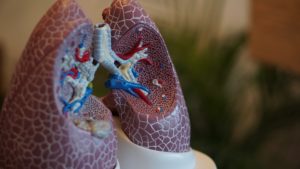

Lung sounds, or breath sounds – the sounds generated by movement or air through the respiratory system, can be classified as either normal or abnormal (adventitious). As a Nurse Practitioner, you’ll be exposed to many lung sounds. It’s important to know how to differentiate between the sounds and know what they may indicate during a physical assessment.
Common Lung Sounds
Bronchial (normal): Heard only over the trachea; high-pitched
Bronchovesicular (normal): Heard over the main bronchus area and over the upper right posterior lung field, medium-pitched.
Crackles (adventitious): Discontinuous in nature, crackles can be high or low-pitched and occur during inspiration. They sound like cracking, clicking or rattling. These sounds can be heard in pneumonia, pulmonary edema, tuberculosis, or bronchitis.
Inspiratory gasp: This sound is continuous and typically high-pitched. It is heard on inspiration and has a “whooping” sound quality. This is the sound heard when someone has pertussis “whooping cough.”
Pleural friction rub (adventitious): Continuous in nature, they are low-pitched and heard on inspiration and expiration. They are non-musical and have many repeated rhythmic sounds. A pleural friction rub can indicate inflammation of the lung lining (pleura) and in the presence of lung tumors.
Rhonchi (adventitious): These sounds resemble the sound someone makes with snoring. They occur when air is blocked or airflow becomes rough through the medium-sized airways, they most often are heard with secretions.
Wheezing (adventitious): these high-pitched sounds are produced by narrow airways. They are most often heard on expiration. Wheezing can sometimes be heard without a stethoscope.
Stridor (adventitious): Continuous in nature, stridor is a high-pitched sound heard on either inspiratory or expiration, mostly inspiratory. They are whistling or musical in nature. This sound can be present in epiglottitis, foreign body obstruction, laryngeal edema, or croup.
Vesicular (normal): Heard over most of the lung fields; low pitch; soft and short expirations.
If you liked this tip, be sure to check out our other resources for pre-NP students, NP students, and practicing NPs. Shop our NP clinical products here and remember to join our Facebook group for board review questions!
View comments
+ Leave a comment